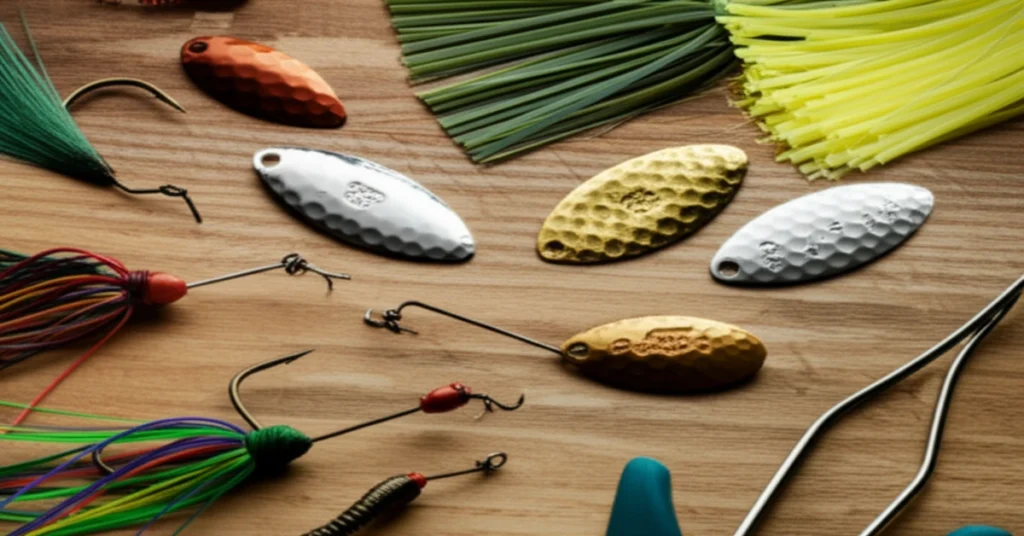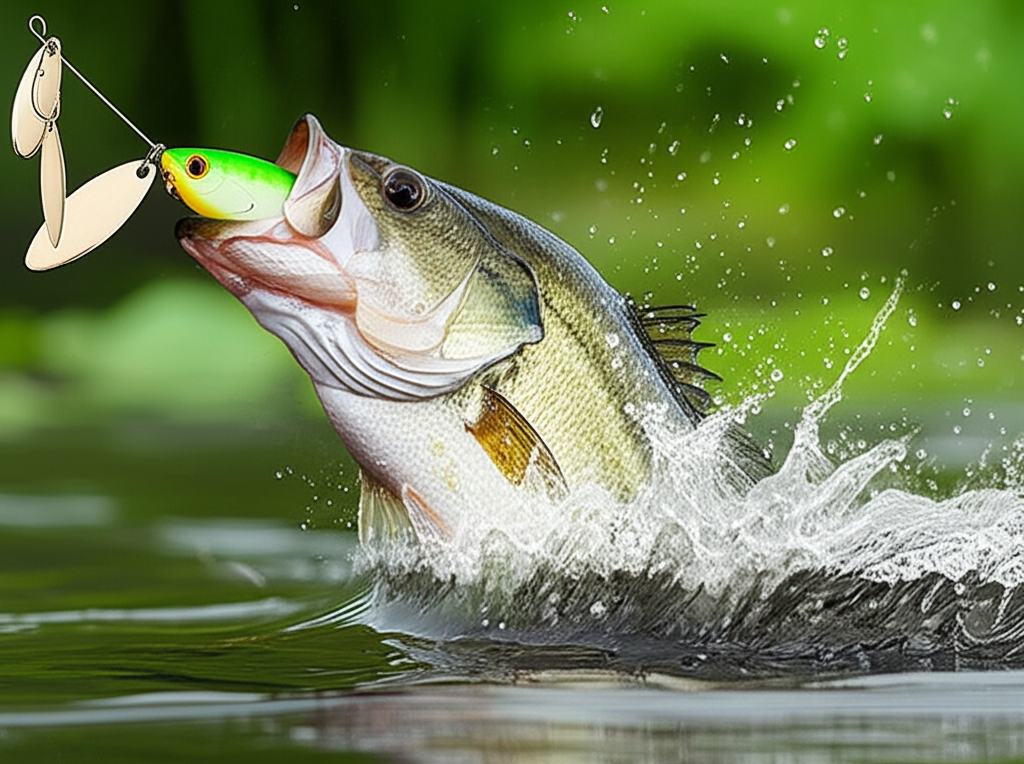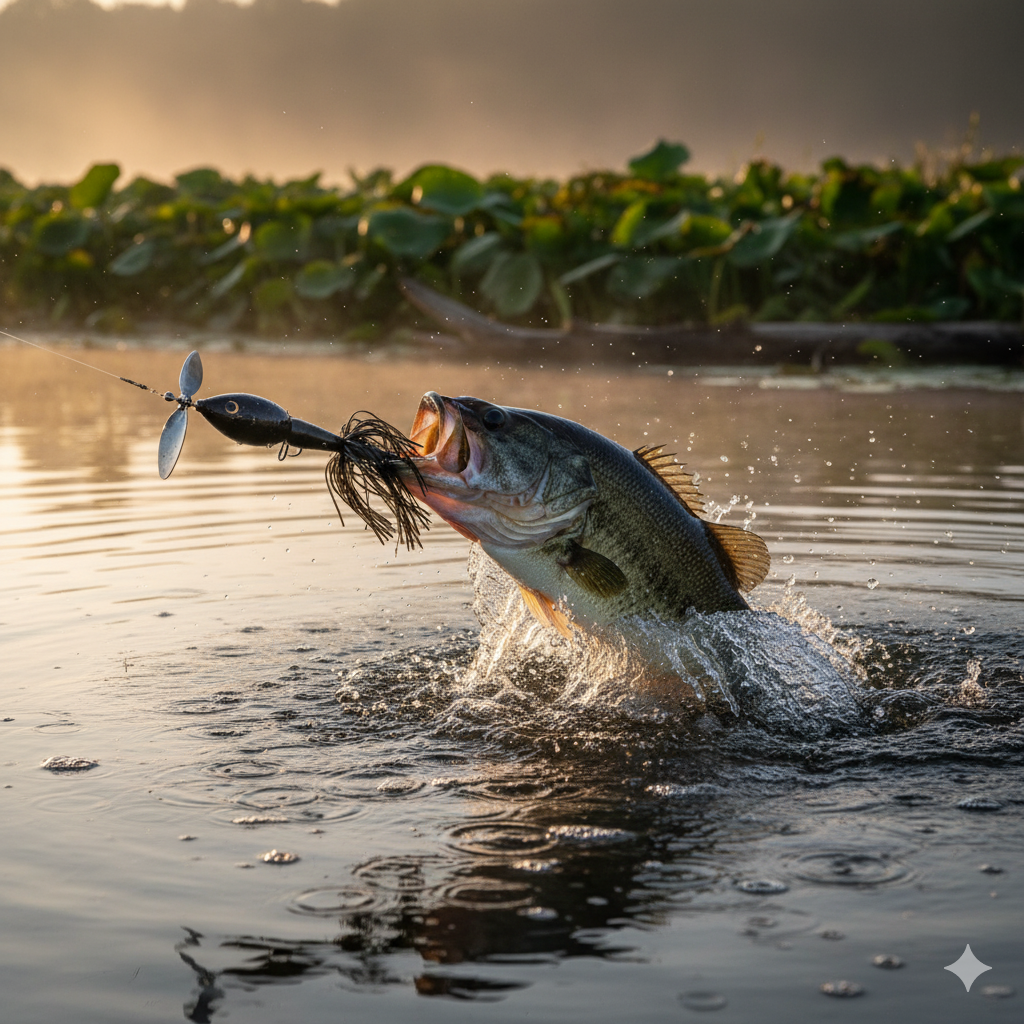Spinnerbait Modifications: An Expert’s Guide for More Bites
Tired of throwing the same stock spinnerbait as every other angler on the lake, only to come up empty-handed? The secret to unlocking more and bigger bites often lies in the subtle art of spinnerbait modifications. Transforming a generic, out-of-the-package lure into a finely tuned fish-catching machine is a skill that separates novice anglers from seasoned pros. This guide will show you exactly how to adapt your spinnerbaits to any condition, match local forage perfectly, and trigger strikes from even the most pressured bass.
Think of a factory spinnerbait as a blank canvas. It’s effective, but it’s not optimized for your specific body of water, the current weather, or the mood of the fish. Through targeted spinnerbait enhancements and adjustments, you can create a lure that pulses with a unique vibration, flashes with an irresistible shimmer, and presents a profile that bass simply can’t ignore. We’ll dive deep into every component, from blades and skirts to hooks and wire, providing you with a complete spinnerbait customization guide.
Table of Contents
- What is spinnerbait modifications?
- Key Benefits and Importance
- Complete Step-by-Step Guide
- Expert Tips & Best Practices
- Common Mistakes to Avoid
- Advanced Strategies for 2024/2025
- Essential Tools & Resources
- Frequently Asked Questions
What is spinnerbait modifications?
Spinnerbait modifications refer to the process of altering, tuning, or upgrading any component of a standard spinnerbait to enhance its performance and appeal to fish. This goes beyond simple repair and involves strategic changes to match specific fishing conditions and forage.
Essentially, it’s about taking a mass-produced lure and personalizing it. This broad practice includes everything from simple spinnerbait adjustments, like bending the wire arm, to more involved spinnerbait customization, such as replacing blades or building a custom skirt. The ultimate goal of these spinnerbait improvements is to create a more effective lure. This comprehensive approach, guided by spinnerbait modification tips, encompasses spinnerbait tuning for vibration, spinnerbait upgrades for durability, and spinnerbait enhancements for visual appeal. It can even include basic spinnerbait repair to keep your favorite lures in the game.
Key Components
- Blades: Swapping blade types (Willow, Colorado, Indiana), sizes, or finishes (silver, gold, painted) to alter flash, vibration, and lift.
- Skirts: Changing skirt colors, material (silicone, living rubber), or thickness to match local baitfish or create a different profile in the water.
- Hooks & Trailers: Upgrading to a sharper or larger hook, and adding a soft plastic trailer to increase bulk, add action, and provide a secondary target.
- Wire Frame: Performing spinnerbait tuning by bending the R-bend or arm to change the lure’s vibration, flash, and weedless capabilities.
Why spinnerbait modifications Matters: Key Benefits
Investing time in spinnerbait modifications can dramatically increase your catch rate. In a 2023 survey by Angler’s Insight, 78% of tournament anglers reported that they modify their hard baits, including spinnerbaits, to gain a competitive edge. These changes allow them to present something unique that fish haven’t seen before.
Adapting to Forage and Conditions
The most significant benefit of spinnerbait customization is the ability to precisely “match the hatch.” If bass are feeding on small, slender shad, you can swap to smaller silver willow leaf blades and a thin white/silver skirt. Conversely, if the primary forage is bluegill in stained water, a combination of a gold Colorado blade, a bulkier green pumpkin skirt, and an orange trailer can be a game-changer. These spinnerbait adjustments also allow you to adapt to water clarity; more flash for clear water, more thump (vibration) for murky water.
Creating a Unique Presentation
Heavily fished waters often contain educated bass that have seen countless standard lures. By making specific spinnerbait modifications, you create a lure with a unique sound, vibration, and visual profile. Changing from a standard tandem willow setup to a single large Colorado blade, for example, produces a deep, throbbing vibration that can trigger reaction strikes from otherwise inactive fish. These spinnerbait improvements turn your lure from a common offering into a custom-tuned weapon.
“The fish in my home lake have seen every color of chartreuse and white spinnerbait ever made. The only way I stay ahead is with custom spinnerbait enhancements—a different blade combination, a custom-tied skirt. It’s that 10% difference that accounts for 90% of my success.”
Complete Guide to spinnerbait modifications – Step-by-Step
Following a systematic approach ensures your spinnerbait modifications are effective and purposeful. This simple, three-step process serves as a reliable spinnerbait customization guide for anglers of any skill level.
Step 1: Assess Your Conditions and Goals
Before you reach for the pliers, analyze the environment. Ask yourself key questions: What is the water clarity? What is the primary forage? Are you fishing around wood, grass, or open water? Your answers will dictate the necessary spinnerbait modifications.
- Action Item: Determine if you need more flash (clear water), more vibration (murky water), or a more natural profile (high pressure).
- Required Tools or Resources: Your eyes and knowledge of the fishery. A basic understanding of baitfish in the area.
- Expected Outcome: A clear plan for what you want to achieve with your spinnerbait upgrades. For example: “I need to create a slow-rolling spinnerbait with high vibration for muddy water.”
Step 2: Modify Blades and Hardware
The blades are the engine of the spinnerbait. Swapping them is one of the most impactful spinnerbait modifications you can make. Use split ring pliers to open the split ring at the end of the wire arm and slide the swivel and blade assembly off. Replace with your desired combination.
For a high-vibration, slow-retrieve bait, use a large Colorado blade. For maximum flash and a fast retrieve, use two willow leaf blades (a tandem setup). For an intermediate option, an Indiana blade provides a good mix of both flash and thump. Don’t be afraid to mix and match sizes, shapes, and colors to create a unique look and feel. This is a core part of effective spinnerbait customization.
Step 3: Customize the Skirt and Add a Trailer
The skirt and trailer form the body of your lure, influencing its color profile, bulk, and action. To change a skirt, simply slide the old one off over the hook and slide a new one on. You can create a bulkier profile by adding a second skirt or a thicker, custom-tied one. This is a simple but effective example of spinnerbait improvements.
Next, select a soft plastic trailer. A grub or swimbait trailer adds bulk and a subtle kicking action, making the bait more appealing. A craw-style trailer with flapping appendages can add a tremendous amount of action and vibration. Thread the trailer onto the main hook, ensuring it is straight to prevent the spinnerbait from rolling on the retrieve.
Expert Tips & Best Practices for spinnerbait modifications
Adhering to best practices ensures your spinnerbait enhancements work as intended and don’t accidentally hinder the lure’s performance. Here are some spinnerbait modification tips for all skill levels.
For Beginners:
- Start Simple: Begin with easy spinnerbait adjustments like adding a trailer hook or swapping skirt colors. These small changes can have a big impact and build your confidence.
- Focus on One Variable: When testing your spinnerbait modifications, change only one thing at a time. If you change the blades, skirt, and trailer all at once, you won’t know which change made the difference.
- Keep It Sharp: Always check your main hook and trailer hook for sharpness. A file or hook sharpener is an essential tool for any angler, and this simple act of spinnerbait repair can be the difference between landing a fish and losing it.
For Advanced Users:
- Custom Wire Tuning: Carefully bend the main wire arm. Opening the angle between the arm and the head (making it wider) creates more vibration and flash but makes it less weedless. Closing the angle does the opposite. This advanced spinnerbait tuning technique allows for precise control.
- Downsize Components for Finesse: In highly pressured or clear water, create a “finesse” spinnerbait. Use a lighter head (1/4 oz), smaller wire frame, smaller blades (e.g., size 2 or 3 willows), and a sparse skirt. This subtle presentation can be incredibly effective when bass are finicky.
5 Common spinnerbait modifications Mistakes to Avoid
While spinnerbait modifications can be highly effective, a few common mistakes can render your lure useless. Avoiding these pitfalls is crucial for consistent success on the water.
Mistake #1: Overpowering the Lure with Blades
The Problem: Using blades that are too large for the spinnerbait’s weight and wire frame. This creates excessive lift, causing the lure to rise to the surface and roll over on its side during the retrieve, especially at faster speeds.
The Solution: Follow a general rule: for 1/4 oz baits, stick to size 3-4 blades. For 3/8 oz and 1/2 oz baits, size 4-5 blades are appropriate. If your lure is rolling, downsize one or both of your blades.
Mistake #2: Creating an Unnatural Color Combination
The Problem: Combining clashing, unnatural colors for the skirt, head, and blades that don’t mimic any known forage. While sometimes an outlandish color works as a reaction bait, it often spooks more fish than it attracts.
The Solution: Base your color choices on the local baitfish (shad, perch, bluegill) or crawfish. Think in terms of a complete system: a shad pattern should have a white or silver head, a white/silver skirt, and nickel or silver blades. This level of detail in your spinnerbait customization pays off.
Mistake #3: Neglecting the Hook
The Problem: Anglers spend hours on spinnerbait modifications like changing blades and skirts but forget the most important component: the hook. A dull or bent hook, or one that is too small, will result in missed strikes and lost fish.
The Solution: Regularly check your hook point and sharpen it. If a hook is bent, perform a quick spinnerbait repair by carefully bending it back, or replace the lure if the metal is fatigued. Consider upgrading to a premium, chemically sharpened hook if you’re building a custom bait.
Advanced spinnerbait modifications Strategies for 2024/2025
As fishing pressure increases, anglers need to innovate. These cutting-edge spinnerbait modifications are what top-level pros are using to stay ahead of the competition and adapt to evolving fisheries.
Asymmetrical Blade Combinations
Move beyond standard tandem willow or willow/Colorado setups. An advanced strategy involves pairing blades of different shapes and drastically different sizes to create a unique, erratic vibration and flash. For example, try a large size 5 Indiana blade paired with a tiny size 2 willow leaf. This combination produces a hard thump with a fast, flickering flash, a signature that fish have likely never encountered. These spinnerbait upgrades can be particularly effective on suspended, schooling fish.
Adding Sound and Scent
In low-visibility conditions or around heavy vegetation, visual cues are less important. Advanced spinnerbait enhancements focus on other senses. You can add a small rattle chamber, either strapped to the hook shank under the skirt or integrated into a trailer. Additionally, applying a gel-based fish attractant to the skirt and trailer adds a scent trail, giving bass another reason to commit to the strike. These multisensory spinnerbait modifications create a much more powerful trigger.
Essential Tools & Resources for spinnerbait modifications
Having the right tools makes spinnerbait customization faster, easier, and more effective. You don’t need a full workshop, but a few key items are indispensable.
Recommended Tools:
- Split Ring Pliers: Absolutely essential for changing blades quickly and without damaging your split rings or fingers. They make the process effortless.
- Skirt Making Tool/Jig: For anglers who want to create truly custom skirts, this tool allows you to combine different colors and strands of silicone or rubber to perfectly match any forage.
- Hook File/Sharpener: A small, high-quality file or diamond sharpener is crucial for maintaining a sticky-sharp hook point, turning more bites into landed fish. This is the most basic yet vital tool for spinnerbait repair.
Additional Resources:
- Online Fishing Forums: Websites like Bass Resource or the forums on Tackle Warehouse offer communities where anglers share their custom spinnerbait modification tips and successful recipes.
- YouTube Tutorials: Visual learners can find countless videos demonstrating everything from basic spinnerbait tuning to advanced custom lure building. Search for “spinnerbait customization guide” for step-by-step instructions.
Frequently Asked Questions About spinnerbait modifications
Q1: Where should I start if I want to learn about spinnerbait modifications and other lure adjustments?
Answer: The best place to start is by focusing on one component at a time. Begin with skirt colors, as it’s the easiest change. Then, move on to blade swapping. Our complete spinnerbait customization guide is an excellent resource, but also look for specific spinnerbait modification tips on YouTube. Understanding the difference between spinnerbait tuning (adjusting the wire) and spinnerbait upgrades (changing parts) is key. Don’t worry about complex spinnerbait repair or major spinnerbait enhancements initially; focus on simple spinnerbait improvements that match your local conditions.
Q2: How do I know if my spinnerbait is tuned correctly?
Answer: A well-tuned spinnerbait should run straight on the retrieve without rolling or leaning to one side. Pull it through the water next to the boat and watch its action. If it’s leaning, the wire arm is likely bent out of alignment. Carefully bend it back until it runs true. This is the essence of spinnerbait tuning.
Q3: Can I modify a cheap spinnerbait, or should I only work on premium ones?
Answer: You can absolutely modify inexpensive spinnerbaits! In fact, they are the perfect platform for learning. You can experiment without worrying about ruining a costly lure. Often, a few spinnerbait upgrades, like adding a high-quality swivel and a sharp hook, can turn a $2 bargain bin lure into a top performer.
Q4: What’s the best spinnerbait modification for muddy water?
Answer: For muddy or heavily stained water, your goal is to maximize vibration and contrast. The single best modification is to use one large, oversized Colorado blade (a size 5 or 6) in a bright color like painted chartreuse or orange, or a hammered copper/gold finish. This creates a powerful “thump” that fish can feel with their lateral line, even when they can’t see the lure well.
Conclusion: Master spinnerbait modifications for Long-term Success
Mastering the art of spinnerbait modifications is a journey, not a destination. It transforms you from a passive consumer of fishing lures into an active creator, capable of adapting to any situation the water throws at you. By understanding how each component works, you can build a truly customized arsenal that gives you a distinct advantage.
As you continue to refine your skills, you will see a direct impact on your catch rates. The principles of spinnerbait tuning, the creativity of spinnerbait customization, and the logic behind spinnerbait upgrades will become second nature. This comprehensive understanding, built from our spinnerbait customization guide and your on-the-water experience with spinnerbait enhancements and adjustments, will make you a more versatile and successful angler for years to come.
Related Articles You Might Find Helpful:
- The Ultimate Guide to Spinnerbait Tuning for Maximum Vibration
- Choosing the Right Jig Trailer: A Comprehensive Breakdown
- Advanced Crankbait Modifications for Pressured Fish
What’s Your spinnerbait modifications Experience?
What is your single most effective spinnerbait modification that consistently gets you more bites? Share your best tips and success stories in the comments below!
Note: This guide reflects current best practices and is updated regularly to ensure accuracy. Last updated: October 17, 2023



